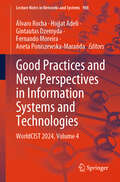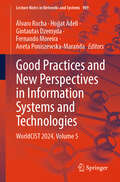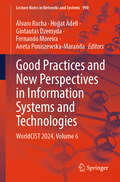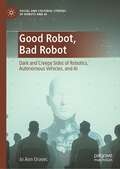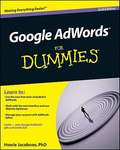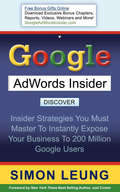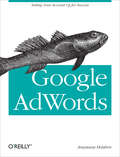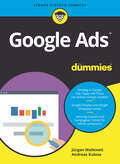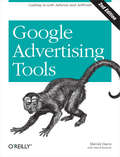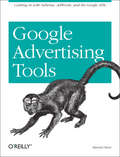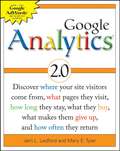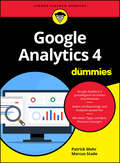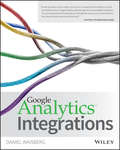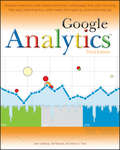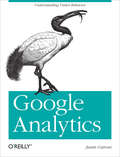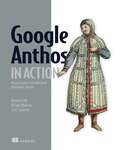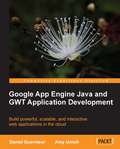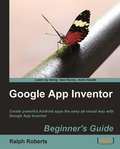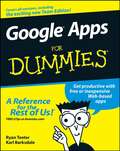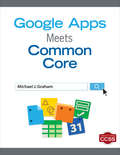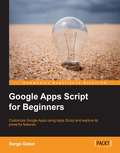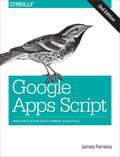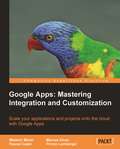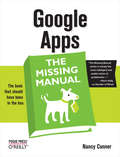- Table View
- List View
Good Practices and New Perspectives in Information Systems and Technologies: WorldCIST 2024, Volume 4 (Lecture Notes in Networks and Systems #988)
by Hojjat Adeli Álvaro Rocha Gintautas Dzemyda Aneta Poniszewska-Marańda Fernando MoreiraThis book is composed by a selection of articles from the 12th World Conference on Information Systems and Technologies (WorldCIST'24), held between 26 and 28 of March 2024, at Lodz University of Technology, Lodz, Poland. WorldCIST is a global forum for researchers and practitioners to present and discuss recent results and innovations, current trends, professional experiences and challenges of modern Information Systems and Technologies research, together with their technological development and applications. The main and distinctive topics covered are: A) Information and Knowledge Management; B) Organizational Models and Information Systems; C) Software and Systems Modeling; D) Software Systems, Architectures, Applications and Tools; E) Multimedia Systems and Applications; F) Computer Networks, Mobility and Pervasive Systems; G) Intelligent and Decision Support Systems; H) Big Data Analytics and Applications; I) Human-Computer Interaction; J) Ethics, Computers and Security; K) Health Informatics; L) Information Technologies in Education; M) Information Technologies in Radiocommunications; and N) Technologies for Biomedical Applications. The primary market of this book are postgraduates and researchers in Information Systems and Technologies field. The secondary market are undergraduates and professionals as well in Information Systems and Technologies field.
Good Practices and New Perspectives in Information Systems and Technologies: WorldCIST 2024, Volume 5 (Lecture Notes in Networks and Systems #989)
by Hojjat Adeli Álvaro Rocha Gintautas Dzemyda Aneta Poniszewska-Marańda Fernando MoreiraThis book is composed by a selection of articles from the 12th World Conference on Information Systems and Technologies (WorldCIST'24), held between 26 and 28 of March 2024, at Lodz University of Technology, Lodz, Poland. WorldCIST is a global forum for researchers and practitioners to present and discuss recent results and innovations, current trends, professional experiences and challenges of modern Information Systems and Technologies research, together with their technological development and applications. The main and distinctive topics covered are: A) Information and Knowledge Management; B) Organizational Models and Information Systems; C) Software and Systems Modeling; D) Software Systems, Architectures, Applications and Tools; E) Multimedia Systems and Applications; F) Computer Networks, Mobility and Pervasive Systems; G) Intelligent and Decision Support Systems; H) Big Data Analytics and Applications; I) Human-Computer Interaction; J) Ethics, Computers and Security; K) Health Informatics; L) Information Technologies in Education; M) Information Technologies in Radiocommunications; and N) Technologies for Biomedical Applications. The primary market of this book are postgraduates and researchers in Information Systems and Technologies field. The secondary market are undergraduates and professionals as well in Information Systems and Technologies field.
Good Practices and New Perspectives in Information Systems and Technologies: WorldCIST 2024, Volume 6 (Lecture Notes in Networks and Systems #990)
by Hojjat Adeli Álvaro Rocha Gintautas Dzemyda Aneta Poniszewska-Marańda Fernando MoreiraThis book is composed by a selection of articles from the 12th World Conference on Information Systems and Technologies (WorldCIST'24), held between 26 and 28 of March 2024, at Lodz University of Technology, Lodz, Poland. WorldCIST is a global forum for researchers and practitioners to present and discuss recent results and innovations, current trends, professional experiences and challenges of modern Information Systems and Technologies research, together with their technological development and applications. The main and distinctive topics covered are: A) Information and Knowledge Management; B) Organizational Models and Information Systems; C) Software and Systems Modeling; D) Software Systems, Architectures, Applications and Tools; E) Multimedia Systems and Applications; F) Computer Networks, Mobility and Pervasive Systems; G) Intelligent and Decision Support Systems; H) Big Data Analytics and Applications; I) Human-Computer Interaction; J) Ethics, Computers and Security; K) Health Informatics; L) Information Technologies in Education; M) Information Technologies in Radiocommunications; and N) Technologies for Biomedical Applications. The primary market of this book are postgraduates and researchers in Information Systems and Technologies field. The secondary market are undergraduates and professionals as well in Information Systems and Technologies field.
Good Robot, Bad Robot: Dark and Creepy Sides of Robotics, Autonomous Vehicles, and AI (Social and Cultural Studies of Robots and AI)
by Jo Ann OravecThis book explores how robotics and artificial intelligence (AI) can enhance human lives but also have unsettling “dark sides.” It examines expanding forms of negativity and anxiety about robots, AI, and autonomous vehicles as our human environments are reengineered for intelligent military and security systems and for optimal workplace and domestic operations. It focuses on the impacts of initiatives to make robot interactions more humanlike and less creepy (as with domestic and sex robots). It analyzes the emerging resistances against these entities in the wake of omnipresent AI applications (such as “killer robots” and ubiquitous surveillance). It unpacks efforts by developers to have ethical and social influences on robotics and AI, and confronts the AI hype that is designed to shield the entities from criticism. The book draws from science fiction, dramaturgical, ethical, and legal literatures as well as current research agendas of corporations. Engineers, implementers, and researchers have often encountered users' fears and aggressive actions against intelligent entities, especially in the wake of deaths of humans by robots and autonomous vehicles. The book is an invaluable resource for developers and researchers in the field, as well as curious readers who want to play proactive roles in shaping future technologies.
Google AdWords For Dummies
by Howie JacobsonA completely updated reference to help you get the most value out of your AdWords campaignsGoogle AdWords is a unique tool that allows you to set your own budget and create ads and choose keywords that are specifically related to your business. When your ad appears next to the search results, people can simply click your ad to learn more about you or make a purchase. This handy guide walks you through the newest tips, tricks, and techniques for maximizing your AdWords campaign.Offering valuable advice, this new edition includes case studies from readers who have shared what they learned from using the techniques revealed in the first edition.A revised and updated guide that shares invaluable advice for maximizing your AdWords campaignDiscusses changes to the AdWords interface as well as best practices in split testing, opt-in landing page structure, and ad group structureReviews new, free tools included in AdWords as well as new and improved third-party toolsIncludes an in-depth explanation of Google's free Web site testing and optimization tool: Website OptimizerIncludes a Google AdWords gift card worth $25 (details inside book)With this handy reference by your side, you will discover the best way to put a Google AdWords campaign to work for you!Note: CD-ROM/DVD and other supplementary materials are not included as part of eBook file.
Google AdWords For Dummies, 3rd Edition
by Howie Jacobson Kristie Mcdonald Joel McdonaldThe fun and friendly guide on getting the most value out of your AdWords campaigns, now updated! Google AdWords is a unique tool that allows you to set your own budget and create ads and choose keywords that are specifically related to your business. This handy guide walks you through the newest tips, tricks, and techniques for maximizing your AdWords campaign. Presenting coverage that is nearly entirely rewritten or revised, this practical guide adds chapters on topics such as ad extensions, feeds for e-commerce, mobile advertising, advanced ad writing, and the new Google display network. In addition, the author provides updates that reflect helpful new best practices. Boasts approximately 85 percent updated or new content Updates popular topics such as experiments, ad extensions, feeds for e-commerce, mobile advertising, advanced ad writing, and more Incorporates changes to the AdWords interfaces Shares best practices in split testing, opt-in landing page structure, and ad group structure Reviews new, free tools included in AdWords as well as new and improved third-party tools With this handy reference by your side, you'll discover the best way to make a Google AdWords campaign to work for you!
Google AdWords Insider: Insider Strategies You Must Master to Instantly Expose Your Business to 200 Million Google Users
by Simon LeungGoogle AdWords Insider, written by a true Insider, explains the mysteries behind advertising with the world&’s number one search engine. Simon Leung is a retired AdWords Optimization Specialist from Google Headquarters who developed the strategies used today to train the Google Team internally, many of which are shared in this highly acclaimed book. Whether a beginner or expert to Internet Marketing and online advertising, you will learn to understand Google AdWords the way the system understands itself, grasping the key to minimizing your costs while maximizing your return on investment through fundamental keyword, ad text, account structure and landing page optimization.
Google AdWords: Managing Your Advertising Program (Oreilly And Associate Ser.)
by Anastasia HoldrenDo people really click the handful of text ads that accompany Google search results? Absolutely. Growth of Google AdWords continues to increase, as does online advertising in the United States. This book shows you how each piece of Google’s advertising platform works, focusing on areas that impact the performance and cost of your ad campaigns.Learn how to create an AdWords account, and then dive into the particulars of setting up your first campaign, optimizing keywords, writing effective ads, and tracking conversions. Most advertisers don’t understand how AdWords works. This book gives you an edge.Learn the advantages of proper account structure based on tightly knit themesUnderstand AdWords auction and the importance of keyword Quality ScoreDetermine your preferred bidding model and daily ad budgetEvaluate campaign performance by timeframe, keyword, and other criteriaHone your keyword list whenever search queries trigger your adsAdd negative keywords to filter out irrelevant queriesOutperform competitors and organic search results with targeted ad copyDetermine conversion goals, and use AdWords tools to track them
Google Ads für Dummies (Für Dummies)
by Andreas Kulosa Jürgen Walleneità ber Google Ads kann man seine Bekanntheit steigern und Verkäufe initiieren. Sie lernen in diesem Buch, die Leistungsfähigkeit von Google Ads optimal zu nutzen und mit hilfreichen Tricks schnell, effizient und messbar Umsätze zu steigern. Entdecken Sie die Geheimnisse von Google Search, Google Display, Werbung auf YouTube und Google Shopping. Jürgen Walleneit und Andreas Kulosa zeigen Ihnen, wie Sie Ihr Unternehmen richtig bewerben und Ihre Angebote bestmöglich platzieren.
Google Advertising Tools: Cashing in with AdSense and AdWords
by Harold Davis David IwanowWith this book, you'll learn how to take full advantage of Google AdWords and AdSense, the sophisticated online advertising tools used by thousands of large and small businesses. This new edition provides a substantially updated guide to advertising on the Web, including how it works in general, and how Google's advertising programs in particular help you make money. You'll find everything you need to work with AdWords, which lets you generate text ads to accompany specific search term results, and AdSense, which automatically delivers precisely targeted text and image ads to your website. Google Advertising Tools focuses on best practices, with several case studies that demonstrate which approaches work well, which don't, and why. Google's ad programs can help any business with a web presence, and this guide explains precisely how to use them.Learn how to create effective campaign plans for your websiteUnderstand the PageRank algorithm, Search Engine Optimization (SEO), and Search Engine Marketing (SEM)Drive traffic to your website and make money as an advertising hostAdd AdSense code and Google search to your siteLearn how content, search, and referral ads performCreate and edit AdWord campaignsMonitor AdWords activity and improve your campaign's performance
Google Advertising Tools: Cashing in with AdSense, AdWords, and the Google APIs
by Harold DavisWhen it comes to advertising on the web, you just can't argue with the numbers. A $7 billion market today is expected to grow to $18.9 billion by 2010. Jupiter Research also estimates that search advertising will be a larger share of the market than display advertising by 2010. These phenomenal numbers are due largely to Google, which has changed the way the world publishes content - and advertises.Google Advertising Tools from O'Reilly examines the business and technology behind making money with content and advertising on the web. This focused, easy-to-read guide shows you how to use Google's advertising services to make it happen. You'll find all the background information you need to work with Google AdSense, which automatically delivers text and image ads that are precisely targeted to your site, and Google AdWords, which lets you generate text ads that accompany specific search term results.This book has specific and detailed sections on:Turning your web site into a profit center with AdSenseMaking sense of AdSense metricsDriving traffic to your siteOptimizing sites for search engine placementWorking with AdWords campaigns, auctions, and reportsManaging campaigns dynamically using the AdWords APIsOnce you've read all four parts, you'll have a comprehensive picture of how advertising works on the web and how you can use the Google advertising programs to your advantage.
Google Analytics 2.0
by Tyler Mary E. Ledford JerriSite statistics give you raw numbers, but Web analytics crunch those numbers into meaningful metrics you can actually use. Here's what's new in Google Analytics 2. 0, such as cross-segment reporting and drilldown content that enhance analysis. Learn to set up Analytics and choose filters, explore goals and goal-setting, use customizable dashboards and date ranges, and master basic analytics and Web statistics concepts. Examine every aspect of available reports, learn to use those best suited for e-commerce sites, and more. BONUS: Each copy of Google Analytics 2. 0 includes a $25 Google AdWords gift card compliments of Google. With this $25 gift card , you can attract new customers to your website on Google's dime.
Google Analytics 4 für Dummies (Für Dummies)
by Patrick Mohr Marcus StadeMit diesem Buch bleiben Sie on track Starten Sie in die Web-Analyse mit Google Analytics 4. Dieses Buch ist das richtige für Sie, egal, ob Sie bereits mit Google Analytics gearbeitet haben oder nicht. Patrick Mohr und Marcus Stade zeigen Ihnen, wie Google Analytics 4 aufgebaut ist, wie Sie es implementieren und wie Sie Daten interpretieren. Sie lernen, wie Sie Webseiten auswerten und Kampagnen analysieren. Außerdem erfahren Sie, wie Sie Reports richtig interpretieren und erstellen, und das anhand von vielen Tipps und Best-Practice-Anleitungen. So können Sie die Nutzer Ihrer Webseiten besser verstehen und das Besuchererlebnis optimieren. Sie erfahren Was ein Event ist und welche Arten von Events es gibt Wie Sie Google Analytics 4 implementieren Warum die Definition der Tracking-Anforderungen so wichtig ist Wie Sie Erkenntnisse aus Reportings gewinnen
Google Analytics Integrations
by Daniel WaisbergTurn Google Analytics into a centralized marketing-analysis platform Are you looking to get more useful data about your customers' behavior? Google Analytics Integrations paves the way. Written by Google expert Daniel Waisberg, this step-by-step guide shows you how to integrate and analyze AdWords, Webmaster Tools, AdSense, YouTube, DoubleClick, and other tools using the Google Analytics interface. Many marketers are still seeing only a single part of their visitors' interaction with their business, rather than all the factors and data that affect their websites and apps. This happens mainly because data is scattered over multiple data silos, making it hard for professionals to integrate all sources of information into one place. Google Analytics Integrations offers practical and easy-to-implement guidance on getting around those tricky roadblocks, arming you with the know-how to capture the information you need to get to know your customer base and make your brand grow. Includes best practices for setting up the Google Analytics interface Offers proven techniques to gather clean and accurate customer data Provides straightforward guidance on keeping the implementation under control Shows you how to integrate and import all of your data into Google Analytics You will learn proven techniques to gather clean and accurate data from the outset, as well as a straightforward way to keep the implementation under control, which is especially important for large enterprises. Harness the full power of Google Analytics to get better results and drive revenue with Google Analytics Integrations
Google Analytics, 3rd Edition
by Joe Teixeira Jerri Ledford Mary E. TylerGet the most out of the free Google Analytics service-and get more customers Google Analytics allows you to discover vital information about how end users interact with their Web sites by collecting vital data and providing tools to analyze it, with the intention of improving the end-user experience and, ultimately converting users into customers. This indispensible guide delves into the latest updates to the newest version of Google Analytics-3. 0-and explains the concepts behind this amazing free tool. You'll discover what information to track, how to choose the right goals and filters, techniques for reading Google Analytics reports and graphs, and, most importantly, how to compile this data and use it to improve your Web site and attract more potential customers. Takes an in-depth look at Google Analytics 3. 0 and walks you through the possibilities it offers Explains how to read Google Analytics reports and graphs so that you can compile this data and use it to improve your Web site and attract more users Shares techniques for converting end users into customers Features tips and suggestions for getting the information you need from Google Analytics reports and then converting that information into actionable tasks you can use With Google Analytics, Third Edition, you&'ll be well on your way to retrieving the information you need to convert visitors to your site into customers! Note: CD-ROM/DVD and other supplementary materials are not included as part of eBook file.
Google Analytics: Understanding Visitor Behavior
by Justin CutroniDo you know what people do when they visit your website or web app? Or how much the site contributes to your bottom line? Google Analytics keeps track and makes it easy for you to learn precisely what's happening. This hands-on guide shows you how to get the most out of this free and powerful tool -- whether you're new to Google Analytics or have been using it for years.Google Analytics shows you how to track different market segments and analyze conversion rates, and reveals advanced techniques such as marketing-campaign tracking, a valuable feature that most people overlook. And this practical book not only provides complete code samples for web developers, it also explains the concepts behind the code to marketers, managers, and others on your team.Discover exactly how the Google Analytics system worksLearn how to configure the system to measure data most relevant to your business goalsTrack online marketing activities, including cost-per-click ads, email, and internal campaignsTrack events -- rather than page views -- on sites with features such as maps, embedded video, and widgetsConfigure Google Analytics to track enterprise data, including multiple domainsUse advanced techniques such as custom variables and CRM integration
Google Anthos in Action: Manage hybrid and multi-cloud Kubernetes clusters
by Antonio Gulli et al.Learn multicloud deployment on Anthos directly from the Google development team! Anthos delivers a consistent management platform for deploying and operating Linux and Windows applications anywhere—multi-cloud, edge, on-prem, bare metal, or VMware.Summary In Google Anthos in Action you will learn: How Anthos reduces your dependencies and stack-bloat Running applications across multiple clouds and platforms Handling different workloads and data Adding automation to speed up code delivery Modernizing infrastructure with microservices and Service Mesh Policy management for enterprises Security and observability at scale Google Anthos in Action demystifies Anthos with practical examples of Anthos at work and invaluable insights from the Google team that built it. You&’ll learn how to use this modern, Kubernetes-based cloud platform to balance costs, automate security, and run your software literally anywhere. The book is full of Google-tested patterns that will boost efficiency across the development lifecycle. It&’s an absolutely essential guide for anyone working with Anthos, or delivering software in a cloud-centric world. About the technology The operations nightmare: modern applications run on-prem, in the cloud, at the edge, on bare metal, in containers, over VMs, in any combination. And you&’re expected to handle the rollouts, dataOps, security, performance, scaling, backup, and whatever else comes your way. Google Anthos feels your pain. This Kubernetes-based system simplifies hybrid and multicloud operations, providing a single platform for deploying and managing your applications, wherever they live. About the book Google Anthos in Action introduces Anthos and shows you how it can simplify operations for hybrid cloud systems. Written by 17 Googlers, it lays out everything you can do with Anthos, from Kubernetes deployments to AI models and edge computing. Each fully illustrated chapter opens up a different Anthos feature, with exercises and examples so you can see Anthos in action. You&’ll appreciate the valuable mix of perspectives and insight this awesome team of authors delivers. What's inside Reduce dependencies and stack-bloat Run applications across multiple clouds and platforms Speed up code delivery with automation Policy management for enterprises Security and observability at scale About the reader For software and cloud engineers with experience using Kubernetes. About the author Google Anthos in Action is written by a team of 17 Googlers involved with Anthos development, and Google Cloud Certified Fellows assisting customers in the field. Table of Contents 1 Overview of Anthos 2 One single pane of glass 3 Computing environment built on Kubernetes 4 Anthos Service Mesh: Security and observability at scale 5 Operations management 6 Bringing it all together 7 Hybrid applications 8 Working at the edge and the telco world 9 Serverless compute engine (Knative) 10 Networking environment 11 Config Management architecture 12 Integrations with CI/CD 13 Security and policies 14 Marketplace 15 Migrate 16 Breaking the monolith 17 Compute environment running on bare metal
Google App Engine Java and GWT Application Development
by Amy Unruh Daniel GuermeurThis is a practical guide with a step-by-step approach that builds an application in stages. Each stage of the application is used along with screenshots to introduce or develop your understanding of how to write powerful GAE applications.If you are a developer with prior programming experience of Java development and object-oriented programming and want to understand the key concepts of how to build AJAX web applications with Java, then this book is for you. The book assumes some previous exposure to the basics of using GWT, for example at the level of Google's online introductory GWT tutorials. You don't need to know anything about Google App Engine. This book will teach you everything you need.
Google App Inventor
by Ralph RobertsThis book is written in the Beginner's Guide format that takes the reader through a series of steps to build exciting apps using Google's App Inventor. This book is perfect for people with little or no experience, not just Android developers. No matter your level of experience, you will find plenty of information that you can use to create powerful apps, apps that can be published on Android Market and other places.
Google Apps For Dummies
by Karl Barksdale Ryan TeeterGoogle Apps are Web-based, low-cost (or free!) office productivity tools that do everything those expensive applications do - and you can access them from any computer with an Internet connection. Google Apps For Dummies boosts your "app-titude" by giving you the low-down on choosing, setting up, and using these nifty and powerful gadgets for work or play. Whether you're an individual who wants to take advantage of iGoogle or an organization looking for an enterprise-wide training solution for users at all levels, this comprehensive, practical guide brings you up to speed with all of the basic information and advanced tips and tricks you need to make good use of every Google Apps's tool and capability. Discover how to: Get productive fast with free or inexpensive Web-based apps Design your perfect Start Page layout Choose among the different editions Use Gmail and Google Talk Work with Google Docs and spreadsheet documents Create and collaborate on documents Import events into your calendar Build dazzling presentations Use Dashboard to create and manage user accounts Create a Web page with a unique domain setting Google Apps are poised to shatter the primacy of the current way of working with PCs, saving businesses, schools, government agencies, and individuals big bucks on software, network infrastructure, and administration. Google Apps For Dummies is your key to making this revolutionary new approach work for you and your organization.
Google Apps Meets Common Core
by Michael J. GrahamYour all-in-one solution to college and career readiness in the 21st century! Transform your classroom into a 21st century learning lab for college and career ready students! With step-by-step instructions and numerous screen shots for a variety of Google apps, you’ll learn how to meet and exceed Common Core standards with Google’s suite of free, easy-to-use educational tools. This book includes: Detailed instructions for integrating Common Core technology standards into your curriculum Sample lesson plans and correlations for elementary, middle school, and high school Links to training videos, websites, student samples, and interviews with Google Apps for Education users
Google Apps Script for Beginners
by Serge GabetThis book is a simple step-by-step, example-oriented guide with a focus on providing the practical skills necessary to develop and customize apps with Apps Script. If you are an application developer with no knowledge of App Script, and would like to learn to build apps using Google Apps script from scratch, then this book is for you. Basic JavaScript knowledge is required.
Google Apps Script: Web Application Development Essentials
by James FerreiraLearn how to create dynamic web applications with Google Apps Script and take full advantage of your Google-hosted services. If you have basic coding skills and some JavaScript experience, this practical book shows you how Apps Script works, and provides step-by-step guidance for building applications you can use right away.Apps Script is handy for automating Google Apps tasks, but it also serves as a complete application platform. With this book, you’ll learn how to build, store, run, and share data-driven web apps right on Google Drive. You’ll have access to complete code and working examples that show you how everything fits together.Build an interactive Web App UI that runs on most web and mobile browsersCreate a sample product catalog that displays custom data from a spreadsheetDevelop an application to generate web forms from templatesUse Apps Script to build a simple web-based database applicationDesign a document workflow builder that users can quickly customizeCreate a Google form that lets you select and send email responsesDebug your code and keep track of script problems after deployment
Google Apps: Mastering Integration and Customization
by Médéric Morel Pascal Cadet Manuel AlvesWritten in direct and fast paced style, this book is full of examples and tips to help you make your migration to Google Apps simpler and quicker. After migration, this book will help you get up and running with your new website. This book is for anyone who wishes to use and customize Google Apps in their office environment.
Google Apps: The Missing Manual (Missing Manual)
by Nancy ConnerAmong its many amazing applications, Google now has web-based alternatives to many of the applications in Microsoft Office. This comprehensive and easy-to-follow new book enables you to explore Google's new office applications in detail. Once you do, you'll be in good company -- more than 100,000 small businesses and some corporations are already looking to take advantage of these free Google offerings.Google Apps: The Missing Manual teaches you how to use three relatively new applications from Google: "Docs and Spreadsheets", which provide many of the same core tools that you find in Word and Excel; and Google Calendar and Gmail, the applications that offer an alternative to Outlook. This book demonstrates how these applications together can ease your ability to collaborate with others, and allow you access to your documents, mail and appointments from any computer at any location. Of course, as remarkable as these applications are, Google's office suite is definitely a work-in-progress. Navigating what you can and can't do and -- more importantly -- understanding how to do it isn't always easy. And good luck finding enough help online. Google Apps: The Missing Manual is the one book you need to get the most out of this increasingly useful part of the Google empire. This book: Explains how to create, save and share each of Google's web-based office applications Offers separate sections for Docs and Spreadsheets, Google Calendar, and Gmail Demonstrates how to use these applications in conjunction with one another Gives you crystal-clear and jargon-free explanations that will satisfy users of all technical levels Many of you already use Gmail, but do you know its full potential? Do you know how you can increase its power by using Gmail with Doc and Spreadsheets and Google Calendar? You'll find out with Google Apps: The Missing Manual. You'll also come to understand why large corporations such as General Electric and Proctor & Gamble are taking a long, hard look at these applications.
